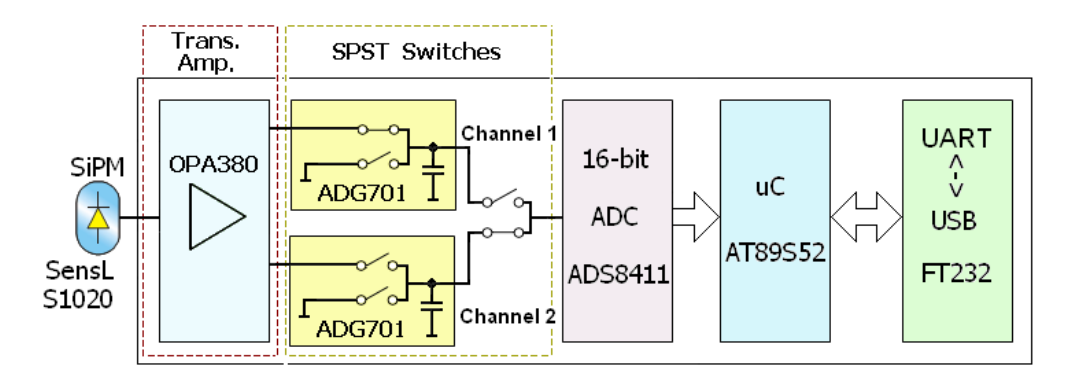Application of the silicon photomultiplier for fluorescence photobleaching measurement
DOI:
https://doi.org/10.5604/01.3001.0010.7556Słowa kluczowe:
silicon photomultiplier, fluorescence photobelaching, sodium fluoresceinateAbstrakt
In the paper a measurement method of fluorescence intensity reduction (called photobleaching) caused by excitation light was presented. Intensity of fluorescence light was measured by silicon photomultiplier (SiPM) – sensor which allows single photons detection. It has more compact dimensions and lower bias voltage in comparison to photomultiplier tube, presently used in many laboratory devices. Standard photometric cuvettes with a capacity of 1.6 ml and optical path length of 10 mm were used for the measurements. Sodium fluoresceinate dissolved in 10 mM TRIS buffer at pH 8.5 was used as the fluorescent dye. The solution was tested at a concentration of 100 μg per ml with constant excitation light from LED source over the time of measurement.
Statystyka pobrań
Bibliografia
L. Song, E. J. Hennink, I. T. Young, and H. J. Tanke, Biophysical Journal, 1995, 68(6), 2588–2600. Google Scholar
Diaspro, G. Chirico, C. Usai, P. Ramoino and J. Dobrucki, Photobleaching – chapter 39, Handbook of Biological Confocal Microscopy, Third Edition, edited by James B. Pawley, 2006, 690–702. Google Scholar
D. Wustner, T. Christensen, L. M. Solanko, and D. Sage, Molecules, 2014, 19, 11096–11130. Google Scholar
Y. M. Yebras, P. Antoranz and J. M. Miranda, Journal of the European Optical Society, 2012, 7, 12014-1–12014-7. Google Scholar
H. Pin Kao, A. S. Verkman, Biopchysical Chemistry, 1996, 59, 203–210. Google Scholar
M. E. van Royen, P. Farla, K. A. Mattern, B. Geverts, J. Trapman and A. B. Houtsmuller, Methods in Molecular Biology, 2009, 464, 363–385. Google Scholar
N. Kourtis, N. Tavernarakis, Protein Synthesis Rate Assessment by Fluorescence Recovery after Photobleaching (FRAP), Bio-Protocol, 2017, 7(5), e2156. Google Scholar
L. Mik, W. Kucewicz, J. Barszcz, M. Sapor and S. Glab, Elektronika: konstrukcje, technologie, zastosowania, 2011, 52(12), 61–65. Google Scholar

Pobrania
Opublikowane
Jak cytować
Numer
Dział
Licencja
Prawa autorskie (c) 2017 Państwowa Wyższa Szkoła Zawodowa w Tarnowie & Autorzy

Utwór dostępny jest na licencji Creative Commons Uznanie autorstwa – Użycie niekomercyjne 4.0 Międzynarodowe.



